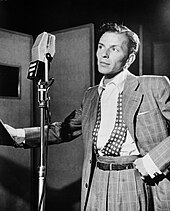Crooner

A crooner is a singer that performs with a smooth, intimate style that originated in the 1920s. The style was made possible by better
Crooning is epitomised by jazz vocalists like Bing Crosby and Frank Sinatra, although Sinatra once said that he did not consider himself or Crosby to be "crooners".[1] Other performers, such as Russ Columbo, also rejected the term.[2]
History

This dominant popular vocal style coincided with the advent of radio broadcasting and
In his popular radio program, which began with his floating greeting, "Heigh ho, everybody," beamed in from a New York City night club, he stood like a statue, surrounded by clean-cut collegiate band musicians and cradling a saxophone in his arms.
His first film,
Some female singers, such as Vaughn De Leath, Annette Hanshaw, Mildred Bailey (at the beginning of her career), Harriet Lee, and Helen Rowland have been cited in the category of crooners.
Country crooners
Due to the country songs popularized by Bing Crosby, the crooning style of singing became an enduring part of
See also
References
Notes
- ^ CBS Special "Sinatra The Legend" recording of It Was A Very Good Year (1965)
- ^ "Russ Columbo Doesn't Croon". Milwaukee Journal. 1 November 1931. Retrieved 24 June 2010.[permanent dead link]
- ^ a b c d e f g h i Whitcomb, Ian. "The Coming of the Crooners". Survey of American Popular Music. Sam Houston State University. Retrieved 24 June 2010.
- ^ Father of Radio: The Autobiography of Lee de Forest, 1950, page 351.
- ^ Irving Settel, A Pictorial History of Radio, p. 58, Grosset & Dunlap (1967).
- OCLC 46976469.
- ^ Bing Crosby, "I'm an Old Cowhand," original mono recordings from 1933-1944, ASV Mono, Living Era, 1995.
- Country Music Television. Retrieved 5 September 2014.
- ^ Dauphin, Chuck (1 August 2014). "billboard.com: A Tribute to Country Crooner Jim Reeves on the 50th Anniversary of His Death". Billboard. Retrieved 6 September 2014.
- ^ Wilonsky, Robert (16 December 2013). "dallasnews.com: Influential country crooner Ray Price dies at 87". Retrieved 6 September 2014.
Further reading
- Gary Giddins, Bing Crosby: A Pocketful of Dreams: The Early Years, 1903–1940. Boston: Little, Brown and Co., 2001.
- Allison McCracken, Real Men Don't Sing: Crooning in American Culture. Durham, NC: Duke University Press, 2015.

